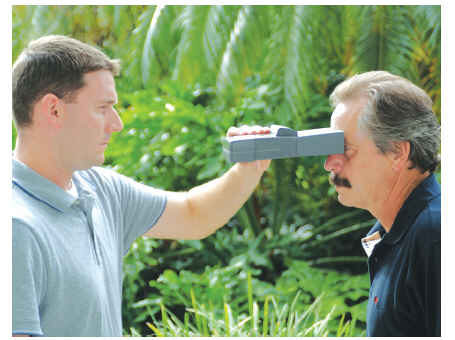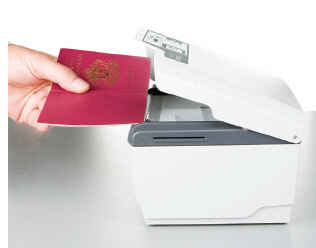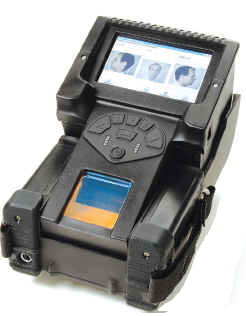.jpg)
By Dr. James Cambier
BIOMETRIC¡¯S DILEMMA
Biometric data, such as fingerprints are embedded within modern passports and visas. This biometric identifier is used to verify the identity of the credential holder. However, the performance of a biometric system may be compromised if there is a change in the identity trait such as a fingerprint altered by an injury that results in a scar. In this instance, the method to match the fingerprint with the stored biometric data may be unreliable.
|

|
|
Compact, man-portable biometric solutions like this are an ideal choice for law enforcement, border control, first responders and the U.S. government agencies to identify subjects and verify their identities in the field. (Photo by Cross Match Technologies) |
BIOMETRIC FUSION
To address this dilemma, organizations are turning to biometric solutions that use different sensors to capture multiple biometric traits. This process is referred to as biometric fusion. Multimodal biometric systems use this approach to meet the exacting identity verification standards of national and private security programs.
Biometric solutions that integrate fingerprint verification, facial recognition and iris scans are at the heart of this emerging trend in biometrics. Multimodal biometric solutions capture varied biometric data for enrollment and file matching. Compact, man-portable solutions are an ideal choice for law enforcement, border control, first responders and the U.S. government agencies to identify subjects and verify their identities in the field.
BENEFITS MULTIPLY
Multimodal biometric systems allow for the fusion of multiple biometric indicators -- combining forensic-quality fingerprint capture, rapid dual iris scan capability and innovative facial recognition technology. By capturing and matching multiple evidences of the same identity, multimodal systems can enhance the accuracy of identity verification programs.
For example, when iris and facial recognition data are combined with fingerprint images stored on a passport or identification card, the reliability of identity verification is enhanced. Using three biometric identifiers can increase the accuracy of identity management programs; thereby controlling access to restricted areas and sensitive data.
|

|
|
Biometric data, such as fingerprints are embedded within modern passports and visas. This biometric identifier is used to verify the identity of the credential holder. (Photo by Cross Match Technologies) |
3 LEVELS OF BIOMETRIC FUSION
Multimodal biometric systems overcome the limitations of single biometric solutions by leveraging the capabilities of each biometric trait.
Studies have shown that identities established using an integrated system can be more reliable than those established using a single biometric. To accomplish this, fusion of the biometric data is essential.
Fusion of biometric data can be performed at several stages during the identity verification process.
Feature Level
At the feature level, raw or processed data such as fingerprint images or templates are combined and then matched against similar fused enrollment data sets, such as a watch list.
Score Level
At the score level, match scores from multiple biometric modalities -- e.g., facial, iris and fingerprints -- are combined to generate a composite score. This may also take into consideration the quality of the biometric samples submitted.
Decision Level
At the decision level, fusion involves making independent match decisions for each biometric modality, and then combining the decision outcomes into a final score.
ADVANTAGES OF SCORE LEVEL FUSION
There are merits to performing fusion at the feature, score or decision level; however, experience shows that score level fusion is optimal for increasing accuracy during the identity verification process.
For instance, the Cross Match Fusion Solution, based on score level fusion can accommodate wide variations in quality scores from different biometric types, and also effectively handles missing samples.
SCORE LEVEL FUSION BASICS
Score-based fusion uses similarity scores generated by individual biometric matching algorithms that are transformed to produce normalized scores that can be combined into a single fused score. The normalization algorithms use information derived from statistical distributions of similarity scores and quality scores. Typically, the score distributions generated and used by score level fusion solutions conform to ANSI/INCITS 439:2008 Fusion Information Format for Data Interchange. This standard defines a robust, flexible data format for score distributions and other fusion information that supports interoperability across multiple biometric modalities, algorithms, and vendors.
|

|
|
Cross Match SEEK with facial photos (Photo by Cross Match Technologies) |
BIOMETRIC KEYWORD: FUSION
Most biometric systems today, use a single-biometric modality for the verification and identification of individuals. In many applications this is a reliable and cost-effective approach to the use of biometrics. Some applications, however, require the collection of biometric data in harsh environments that can affect capture quality. Subjects being asked to provide samples may be unfamiliar with biometric technology and devices, or may be unable to submit high-quality biometric samples due to age, infirmity, or abnormalities. Biometric fusion, collecting samples using multiple biometric modalities and combining the data, is the optimal means to overcome these sample quality issues and achieve the best possible recognition results.
As the use of biometrics to establish identities becomes more prevalent, so will the use of multimodal fusion to address the restrictions of single-mode biometric systems.
Dr. James Cambier is CTO of Iris Technology at Cross Match Technologies, Inc. (http://www.crossmatch.net/). With more than 30 years experience in research, development and program management related to software applications, Cambier has achieved significant milestones, including the development of custom camera system and iris recognition algorithms for animal identification using high-resolution IR imagery.
For more information, please send your e-mails to swm@infothe.com.
¨Ï2007 www.SecurityWorldMag.com. All rights reserved. |



